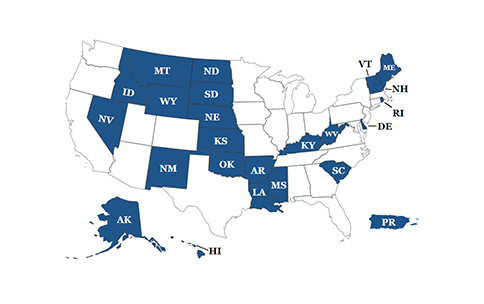
Imagine seeing the natural shape of biological molecules so closely that you can start to identify individual atoms. This dream is a reality for many researchers using a technique called cryoelectron microscopy (cryoEM). Although cryoEM can be a powerful tool, it is often associated with a high-cost barrier and requires specialized training in sample preparation, data collection, and data processing. The Common Fund’s Transformative High-Resolution Cryoelectron Microscopy program is broadening access for biomedical researchers to cryoEM, and a related technique called cryoelectron tomography (cryoET), through the creation of national service centers and training materials. The Centers focus on outreach to institutions and research groups in Institutional Development Award (IDeA)-eligible states as a major component of their mission. IDeA-eligible states are geographical regions of the United States that have historically received low levels of NIH support and often lack infrastructure supporting cryoEM research.
Successful engagement with investigators from IDeA-eligible states requires access to technology for data collection and might also require more hands-on training experiences to introduce researchers from these regions to the entire cryoEM workflow, including the sample preparation and screening steps that precede data collection. The Pacific Northwest Center for Cryo-EM (PNCC) supports a variety of projects from IDeA-eligible states, covering topics such as cancer biology, pharmacology, and therapeutics to combat COVID-19. At PNCC, these often resource-limited researchers can become engaged with cryoEM in a variety of ways. Dr. Lejla Zubcevic is an Assistant Professor at University of Kansas Medical School who studies how molecules are transported across cell membranes to result in temperature and pain sensation. Dr. Zubcevic was previously trained in cryoEM at another institution but her lab lacks the resources to use cryoEM at her current institution. Dr. Zubcevic’s lab is now an independent user at PNCC and uses screening and data-collection resources through a remote-access platform. To further support Dr. Zubcevic’s lab members in preparing samples at their home institution, PNCC also loaned them a cryo-grid clipping station, equipment that enables their complete independence in the cryoEM workflow. PNCC is looking forward to growing engagement between the National Centers for CryoEM and researchers from IDeA-eligible states, like Dr. Zubcevic. Interested researchers should reach out to any of the National Centers for CryoEM for more information about screening and data collection access.
References
- Information about the Common Fund’s National Centers for CryoEM and the National Network for CryoET
- Information about the NIGMS Institutional Development Award (IDeA) program


